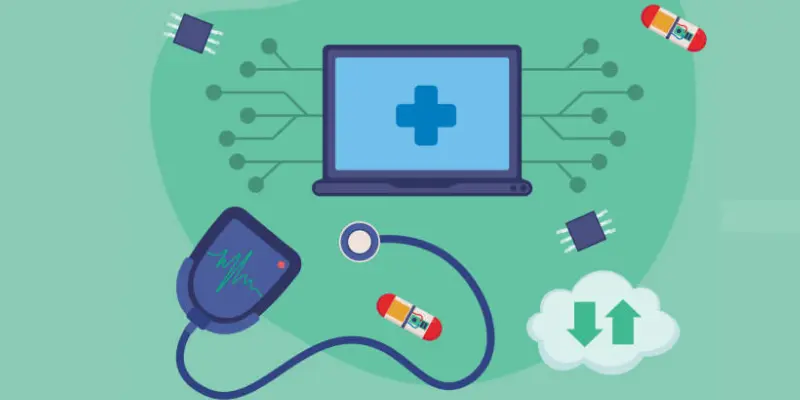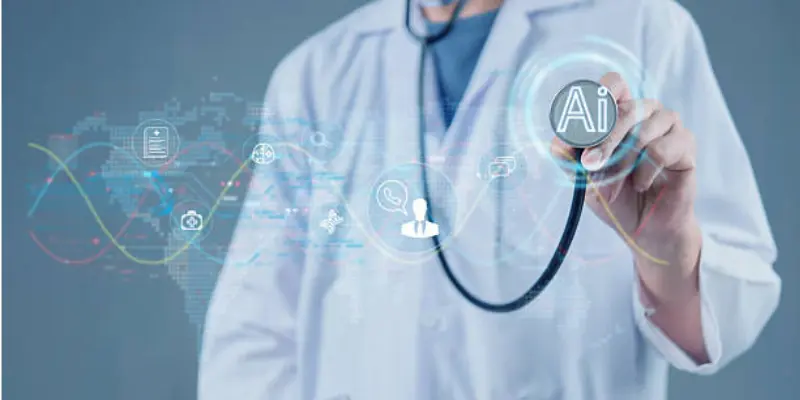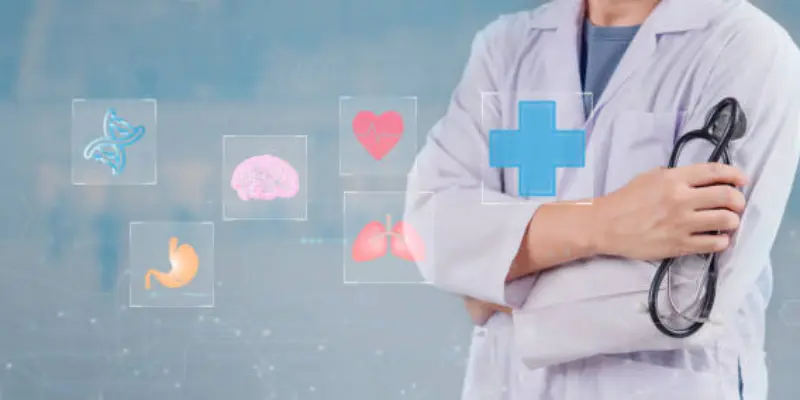AI Stethoscope – The Smart Way to Listen to Hearts
Published: 7 May 2025
Have you ever seen a doctor put a stethoscope on someone’s chest and listen closely? That simple tool helps them hear your heartbeat and breathing. But now, there’s a new kind of stethoscope that does even more. It’s called an AI stethoscope.
An AI stethoscope looks like a regular one but it’s much smarter. It uses artificial intelligence to understand the sounds it hears. It can help doctors to catch heart or lung problems faster and more accurately. That means better care for patients, especially in places where expert doctors are hard to find.
In this blog, I will explore what an AI stethoscope is, how it works and why it matters. Don’t worry we will keep it simple and easy to follow. Ready to hear more?

How Does a Regular Stethoscope Work?
Let’s start with the basics.
A regular stethoscope is a simple tool. Doctors use it to listen to sounds inside your body. These sounds come from your heart, lungs and sometimes your stomach. By listening closely, doctors can tell if something sounds normal or not.
For example: When your heart beats, it makes a “lub-dub” sound. If that sound changes, it might mean there’s a problem. The doctor hears this through the stethoscope’s chest piece which sends the sound through tubes to their ears.
But even with practice, doctors can sometimes miss tiny problems, particularly in noisy places or crowded clinics. That’s where the AI stethoscope comes in and helps fill in those gaps.
What Makes the AI Stethoscope Different?
Now let’s talk about what makes the AI stethoscope special.
It may look like a regular stethoscope but it has something extra inside, a tiny computer with AI. That means it can do more than just pass sounds to a doctor’s ears. It can listen, learn and give feedback in real time.
Here’s what it does:
- It records sounds from your heart or lungs.
- It checks those sounds using AI to spot anything unusual.
- It gives alerts or tips, like “This heartbeat might be irregular.”
Suggested Article: Risks of AI Associated with Diagnosing Diseases
Example:
Let’s say a doctor hears a strange sound but is not sure what it means. The AI stethoscope can quickly analyze it and say, “This might be a heart murmur.” That gives the doctor a head start in figuring out what to do next.
Some AI stethoscopes even show visual charts or color signals to help the doctors in understanding the results better. Green means normal. Red means something might be wrong.
So, instead of just listening, the AI stethoscope also thinks and helps which makes it a powerful tool for smarter care.

Why Is the AI Stethoscope Useful?
The AI stethoscope is not just smart, it’s helpful in many ways. Let’s look at why doctors and nurses are excited about using it.
1. It Finds Problems More Accurately
AI can catch tiny changes in sound that humans might miss. Even trained doctors can sometimes overlook soft or unusual heartbeats. The AI stethoscope listens carefully and spots those issues early.
2. It Works Fast
Doctors don’t have to wait for test results. The AI gives feedback in just a few seconds. This can save time, especially in busy hospitals or emergency rooms.
3. It Helps in Hard-to-Reach Places
In small villages or remote areas, expert doctors may not be available. But health workers with an AI stethoscope can still check patients and send the results to a doctor in a city. That way, people get better care even far from big hospitals.
4. It Supports New or Young Doctors
Doctors in training might not know all the sounds yet. The AI stethoscope acts like a teacher. It gives hints and helps them learn faster while caring for real patients.
In short: The AI stethoscope helps to catch problems early, saves time, supports learning and brings better care to more people. That’s a big win for everyone.
Where Are AI Stethoscopes Used Today?
You might be wondering, where do people actually use AI stethoscopes? The good news is, they are already helping doctors and nurses in many places.
1. Hospitals
In big hospitals, doctors use AI stethoscopes to get quick and accurate results. This helps them make better decisions, especially in emergency rooms or heart clinics.
2. Small Clinics
Not every clinic has a heart expert. But with an AI stethoscope, even a general doctor can spot heart or lung problems early. That means patients get the right help faster.
3. Remote and Rural Areas
In some villages, there are no full-time, experienced doctors. But health workers or nurses can use AI stethoscopes to record sounds and send them to doctors in the city. This helps people get care without traveling far.
Example:
A nurse in a mountain village listens to a patient’s chest using an AI stethoscope. She sees a red warning light and shares the sound with a doctor online. The doctor checks it and suggests treatment right away. This can save lives in places with limited healthcare opportunities.

4. Telehealth Appointments
Many doctors now see patients online. But checking heart or lung sounds can be hard without being there in person. With AI stethoscopes, patients can visit nearby clinics that record and share sounds during the video call. That makes online care more complete.
As you can see, AI stethoscopes are already making a big difference in cities, villages, clinics and even through screens.
How Does the AI Learn to Spot Problems?
You might be asking, “How does a stethoscope know what a heart problem sounds like?” That’s a great question! Let’s talk a quick look
AI Learns Like a Student
An AI stethoscope learns by listening to thousands of real heart and lung sounds. Doctors label these sounds, some are normal, some show problems like murmurs or wheezing. The AI listens and compares them. Over time, it learns which sounds are healthy and which are not.
It Gets Smarter With Practice
Just like students get better by studying, AI improves the more it listens. It finds patterns in the sounds and remembers them. The more it learns, the better it becomes at spotting trouble.
Simple comparison:
Think of teaching a child to recognize a dog’s bark. First, you let them hear many dog sounds. Soon, they can tell, “That’s a bark!” AI works the same way but with heartbeats and breathing sounds.
Doctors Help Train the AI
Medical experts teach and guide the AI. They make sure it learns the right things. This teamwork makes the AI smart, safe and useful in real-life situations.
Are AI Stethoscopes Safe and Reliable?
I can not compromise on my health and that too in the case of heart. Same is the case for you and for everyone. So, It’s natural to ask, “Can we trust an AI stethoscope?” Let’s break it down in a simple way.
1. Tested by Experts
AI stethoscopes go through a lot of testing before doctors use them. Medical researchers and engineers work together to make sure the device works well and gives correct results. Many of these tools are tested in hospitals and approved by health organizations.
2. Doctors Still Make the Final Call
Even though the AI gives suggestions, the doctor always makes the final decision. The AI is just a helper. It gives extra support so doctors can be more confident about what they hear.
Example:
The AI might say, “This sounds like a murmur,” but the doctor checks again, listens carefully and then decides what to do next.
3. Not Perfect, But Getting Better
No tool is 100% perfect. AI stethoscopes can sometimes make mistakes, just like people. That’s why they should always be used with a doctor’s judgment. The good news? They keep learning and improving over time.

4. Challenges to Be Addressed?
While AI stethoscopes are powerful tools, they do come with some challenges. Let’s take a look at a few things to consider.
a. Cost:One of the biggest challenges is the cost. Right now, AI stethoscopes can be expensive.
b. Need for Power and Internet: AI stethoscopes need electricity to work and many of them need an internet connection to send data. In areas with limited power or poor internet access, this could be a problem.
c. Not Always 100% Accurate: Even though AI stethoscopes are smart, they are not perfect. Sometimes, they may miss a problem or give an incorrect alert.
d. Training Required: Doctors and nurses need to learn how to use AI stethoscopes properly. They need training to understand the feedback and alerts the AI gives.
The Future of AI Stethoscopes
What’s next for AI stethoscopes? The future looks exciting and these devices are likely to become even more powerful and accessible. Here’s a glimpse of what we can expect.
1. More Affordable Devices
As technology brings helpful changes in our lives, AI stethoscopes will likely become more affordable. Right now, they can be expensive, but in the future more people could have access to these helpful tools.
2. Smarter Features
AI stethoscopes will keep getting smarter. Imagine a stethoscope that not only detects heart problems but can also predict a person’s risk for future conditions like heart attacks or strokes. This would allow doctors to act even sooner and offer preventative care.
3. Integration with Smartphones and Smartwatches
In the future, AI stethoscopes could work with smartphones or smartwatches. This means you might be able to check your heart or lungs from home and send the data to your doctor with just a few taps on your phone.
4. AI Helping in More Areas
As AI technology grows, we might see AI stethoscopes used in more specialized areas. For example, they could help doctors with detecting lung diseases or chronic conditions. This would make it easier to monitor patients over time and track any changes in their health.
Conclusion
So guys! In this article, we’ve covered the AI stethoscope in detail. It’s clear that this tool has the potential to improve patient care and make doctors’ jobs easier. If you are a healthcare professional or just someone curious about technology, I highly suggest you start learning about AI stethoscopes. It’s an exciting field that’s here to stay. If you found this information helpful, share it with a friend or colleague and let’s keep the conversation going!
FAQs About AI Stethoscopes
Here is the list of faqs:
Current AI stethoscopes range from $300-$2,000 depending on features and capabilities. This is significantly more than traditional stethoscopes which cost $20-$200. As technology advances and production scales up, prices are expected to decrease over time.
Some simpler versions of AI stethoscopes are available for home use, though they have fewer features than professional models. Home versions typically connect to smartphones and cost between $100-$300. Medical professionals should still interpret results, as home devices are meant for monitoring rather than diagnosing.
AI stethoscopes can detect arrhythmias, heart murmurs, valve problems and certain heart defects. For lungs, they can identify wheezing, crackles, reduced air flow and signs of conditions like pneumonia or COPD. The technology continues to improve, allowing for detection of increasingly subtle abnormalities.
Basic training for AI stethoscopes typically takes 1-2 hours for healthcare professionals already familiar with traditional stethoscopes. Becoming proficient with all features and interpreting the AI feedback might require 1-2 weeks of regular use. Many manufacturers offer online training modules and support resources.
AI stethoscope readings are typically stored in secure digital health record systems or cloud platforms with encryption. Access is generally limited to the patient’s healthcare providers and the patient themselves through health portals. Privacy policies vary by manufacturer and healthcare system, so it’s important to review specific terms.
Leading models include the Eko DUO, HD Steth by HD Medical and Stethee Pro. Each offers different features like visualization capabilities, companion apps or specialized algorithms. Research continues to emerge about which models perform best for specific conditions.
Studies show AI stethoscopes achieve 80-90% accuracy for common heart conditions, compared to ECGs at 95%+ accuracy. However, AI stethoscopes are meant as screening tools rather than replacements for comprehensive diagnostic devices. They excel at early detection and triage rather than definitive diagnosis.
Most insurance companies cover examinations using AI stethoscopes similar to traditional stethoscope exams, as they are considered part of a standard physical assessment. Some insurance plans are beginning to offer reimbursement for remote monitoring using AI stethoscopes. Coverage policies continue to evolve as the technology becomes more widespread.
When an AI stethoscope detects an abnormality, it typically alerts the healthcare provider through visual indicators, sounds or text notifications. The provider then uses their expertise to confirm the finding and determine next steps. Depending on severity, this might lead to additional testing, specialist referrals or immediate treatment.
Most AI stethoscopes have some offline capabilities that allow for basic sound amplification and recording without the internet. However, advanced features like AI analysis often require connectivity to access cloud-based algorithms. Some newer models offer limited offline AI processing for basic abnormality detection.





